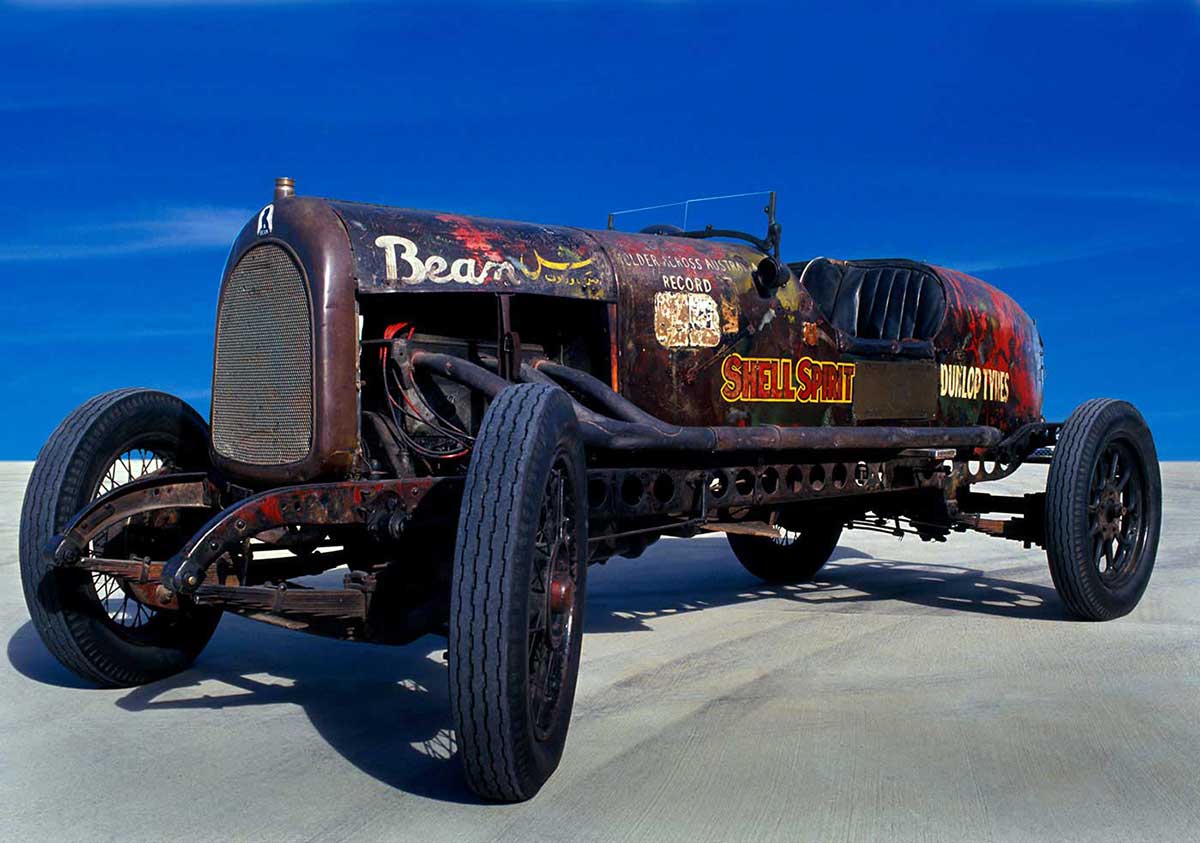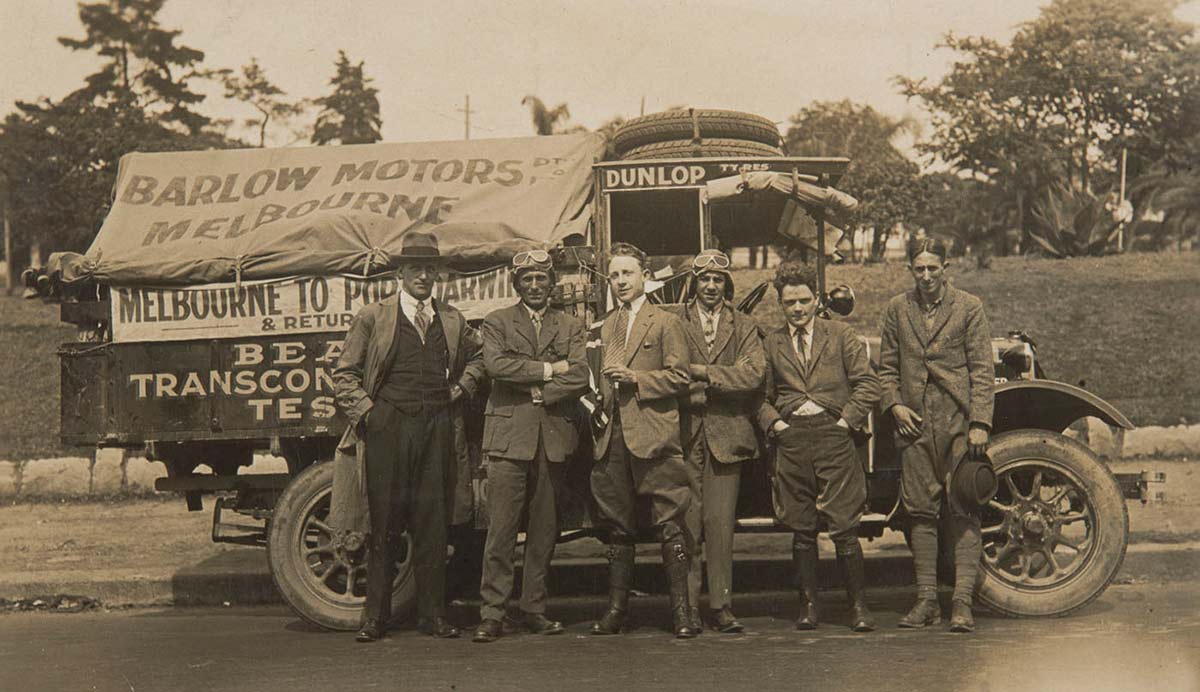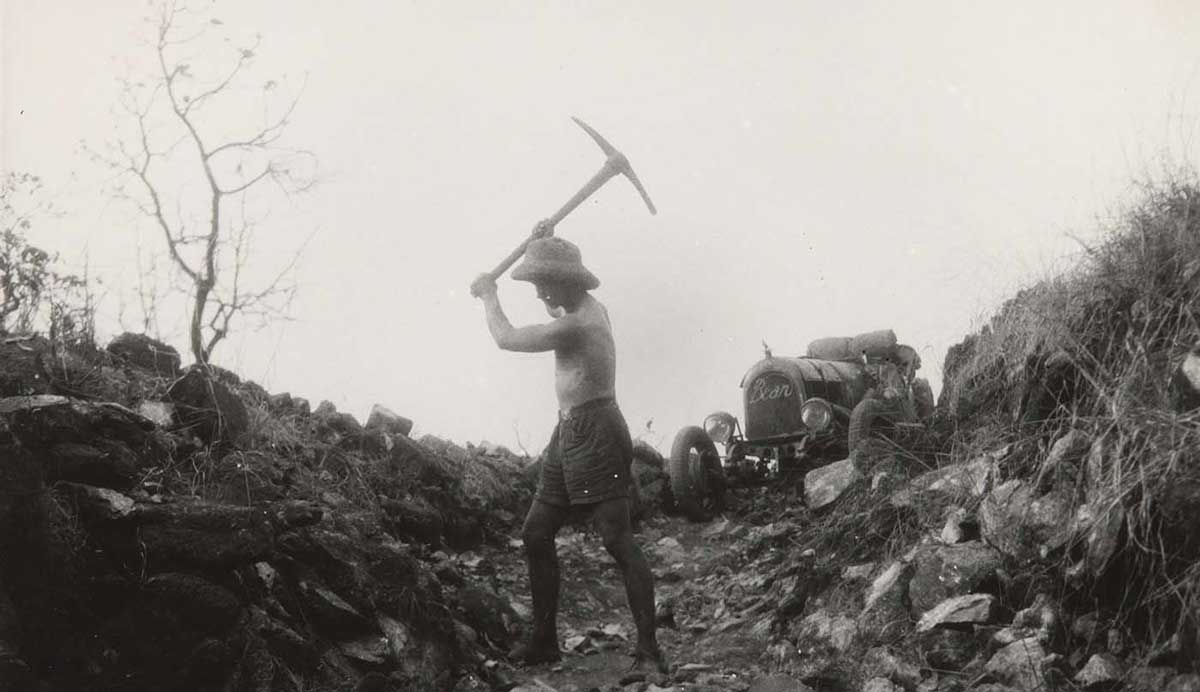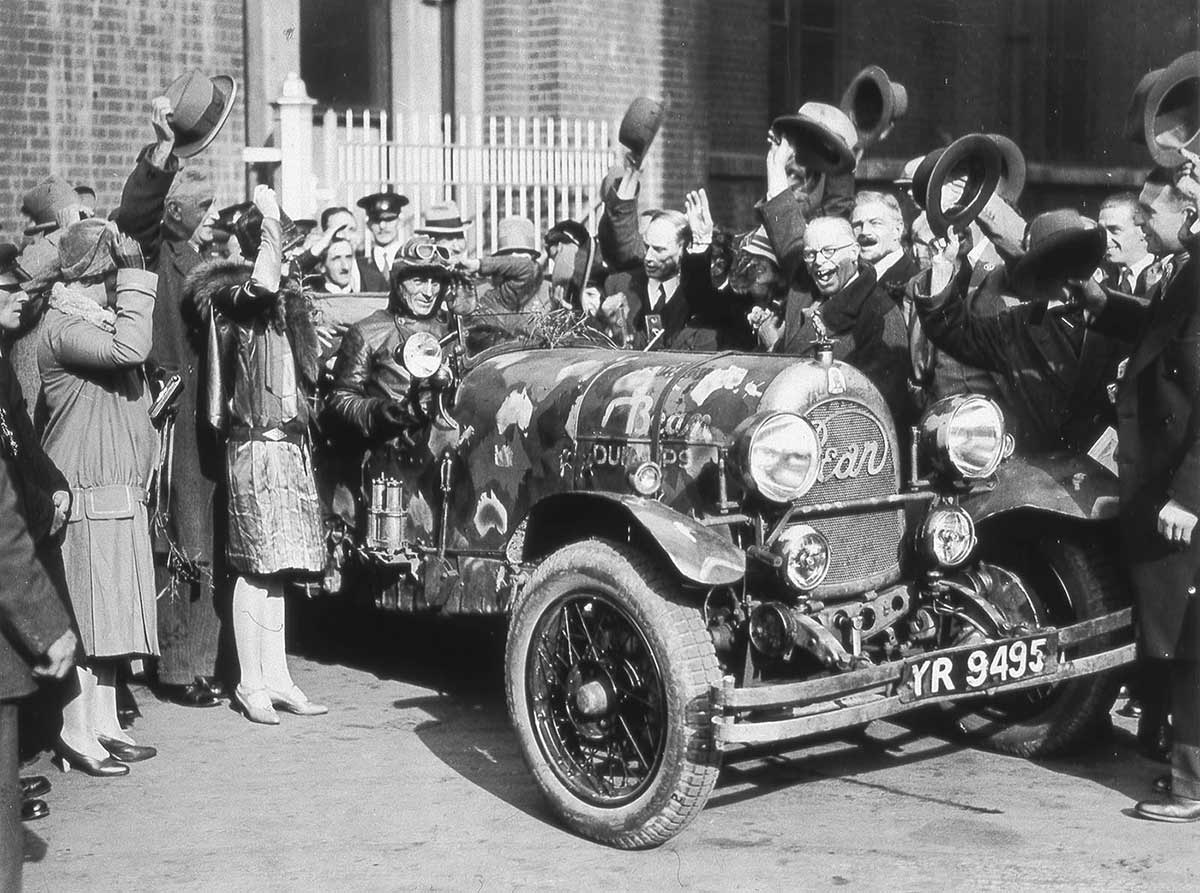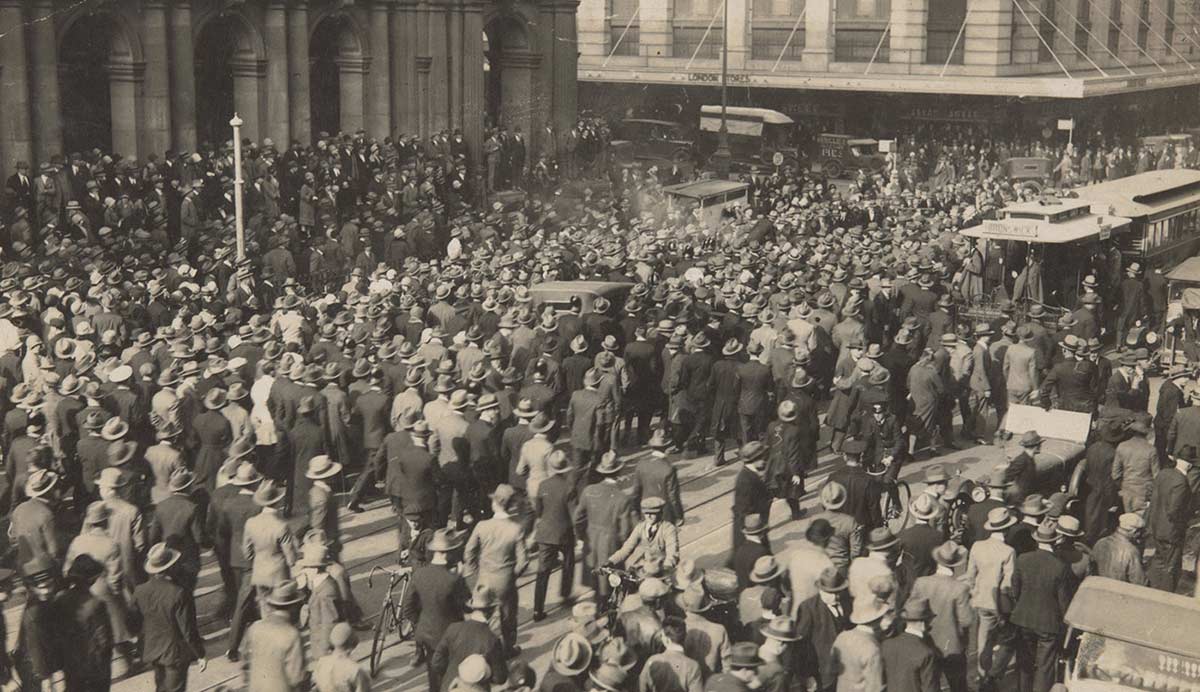Francis Birtles captured Australia’s imagination with his daring and fearless overland journeys in the Sundowner, named for Birtles’ habit of arriving at outback homesteads just in time for dinner.
Exploring Australia and the world
In 1926 Birtles drove from Darwin to Melbourne in a record-breaking eight and a half days. The following year he left London on a 26,000-kilometre trip to Melbourne. It was a backbreaking journey through bush and jungle, across deserts and over mountains, with Birtles often forging roads where none had previously existed.
Museum conservators have spent more than 2000 hours working on the Sundowner. Scratches, dents, sand from the Middle East and mud from South-East Asia – all evidence of Birtles’ remarkable journeys – have been carefully preserved.
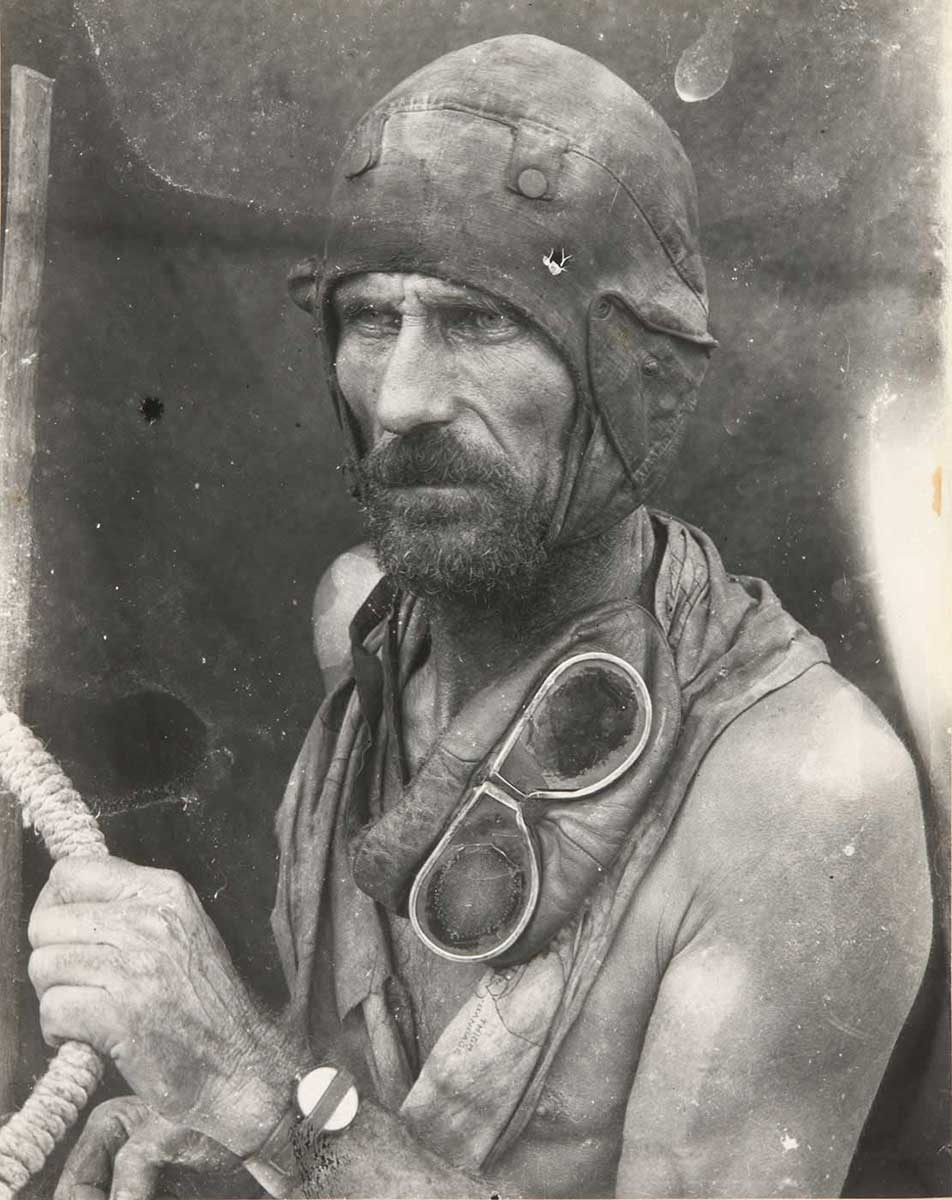
Pioneering motorist
Birtles used bicycles and motor cars to pioneer overland routes and set speed records in the early 20th century.
These early journeys by car were extraordinary feats of endurance, often planned to test the capacity of new technologies in harsh and untried physical conditions.
Technological innovation developed during the First World War allowed for the rise of the automotive industry around the world.
Although the vast distances between urban centres and the lack of reliable roads and other infrastructure restricted the actuality of road travel, the idea of mobility was particularly important to Australians.
The recreational and exploratory potential of the car was showcased by the activities of specialist groups who organised demonstrations of engineering capabilities and highlighted the new opportunity to define and delimit the continent.
Various companies commissioned Birtles to make promotional trips and record his experiences and test their products.
International sponsorship
Capitalising on the short-lived industrial prosperity of the early 1920s, Bean Cars was one company to commission Birtles as a promoter. Based in Worcestershire and Staffordshire, this small British motor car manufacturer aimed to produce and market affordable passenger vehicles to rival Ford's popular 'Model T'.
The famous partnership with Birtles started in 1926 when Bean's Australian agents, Barlow Motors of Melbourne, commissioned him to drive a new two-seater Bean racing car on mostly uncharted road between Darwin and Melbourne, in the shortest possible time.
Birtles' cross-continental expedition aimed to prove suitability of British made goods in an Australian context – particularly to introduce a new Bean truck onto the market and according to an article in the Argus newspaper, to demonstrate 'the speed and stamina of the Bean car.'
The trip relied heavily on other sponsorship. The British Imperial Oil Company provided the Shell motor-spirit, oil millionaire Sir Charles Wakefield supplied the Castrol, and the tyres and tubes were supplied by the Dunlop Rubber Company.
1926 Darwin to Melbourne dash
Birtles and his co-driver, Alec Barlow Jnr (1907–1972) departed Melbourne with great fanfare on 20 September 1926.
They were accompanied by a jaunty Bean support truck driven by mechanics Jack Coughlan and Milton Napthine. Reflecting the media interest in the expedition, the group was also accompanied for part of the way by W Shelton Smith, a journalist for the Argus.
The truck was loaded with the equipment, food supplies, tyres and petrol needed to complete the journey.
After shipping the car to Darwin from Sydney, the party travelled overland in the truck, dropping off petrol and supplies at various points for the Sundowner's return trip via Katherine in the Northern Territory, Dajarra and Cunnamulla in Queensland, and Bourke, Sydney and Albury in New South Wales.
This forward leg of the trip through uncharted land essentially negotiated or in some cases created the route the Sundowner would take during the record-breaking attempt.
With the help of local knowledge they gained along the way, the party mapped a passable route via stock tracks and unsealed roads. In addition to the fierce heat, conditions were treacherous and the heavily-weighted vehicle could barely proceed without being continuously bogged down in thick mud.
Adopting a policy of accelerating the truck through any obstacle in its way, the Sydney Morning Herald reported that the party narrowly avoided serious injury when it skidded and overturned between Narromine and Bourke.
Melbourne to Darwin record
Birtles and Barlow left Darwin on 23 October 1926. In his journal, An epic of the outback, Alec Barlow wrote that the car ran 'wonderfully well eating the miles in a whirl of dust' down through Katherine, Bourke, Sydney and on to Melbourne.
Eight and a half days and some 5500kms of hot and perilous country later, the travel-weary pair arrived in Melbourne to great celebration.
The journey established a record-breaking time for transcontinental travel, and proved the suitability of Bean's vehicles in the harsh Australian environment.
In keeping with the promotional aims of the journey, journalists were quick to effusively praise the car's high performance. Bearing the difficult journey in mind, the claim that Barlow never had to break out a spanner was hard to believe.
No doubt buoyed by the lavish publicity, Birtles was gifted the car by Bean in recognition of the feat.
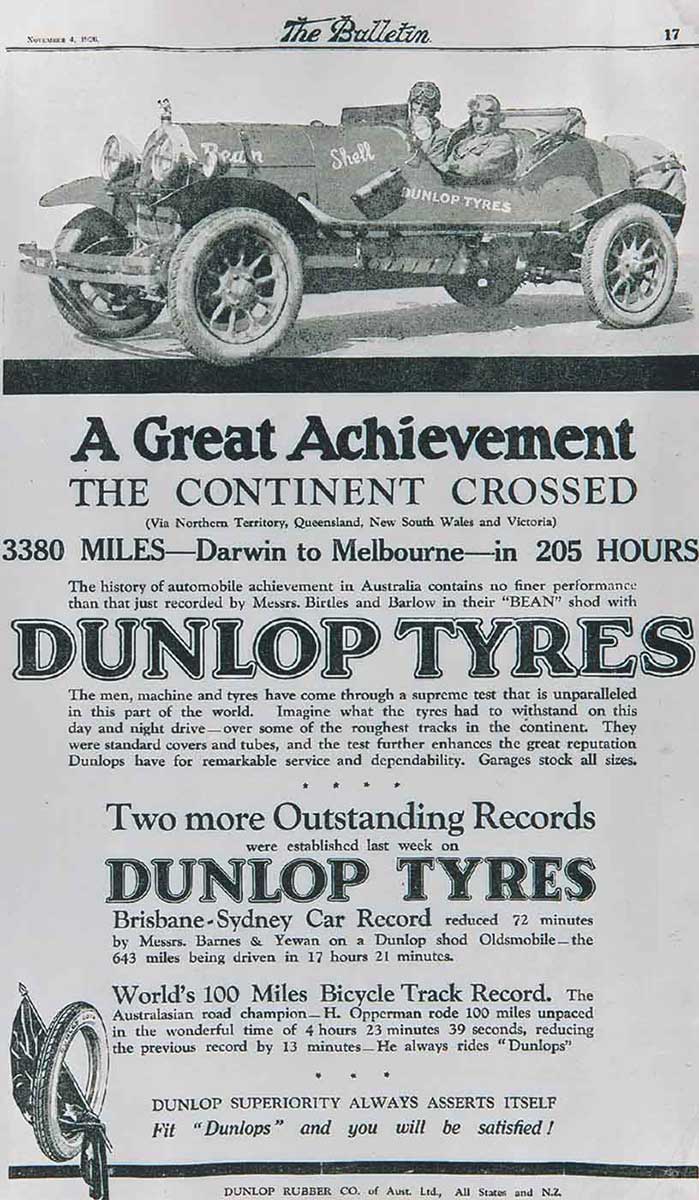
London to Melbourne second attempt
In 1927 Birtles set his sights further afield: the vast stretches of landscape between London and Melbourne.
In comparison with today's great car rallies, such as the off-road Paris to Dakar race, this journey remains an astonishing feat of mental and physical endurance over a punishing nine months.
Previous motoring trips had traversed the land between England and India but no British-made motor cars had ventured onwards beyond the precipitous Naga Hills which spanned the border between India and Burma (Myanmar).
Intending to prove the mettle of their newest six-cylinder car, the Imperial Six, Bean once again saw Birtles as the man to take the wheel. Along with two other drivers, Malcolm Ellis and Billy Knowles, the group left London in February 1927.
However, unlike the tried-and-tested Sundowner, the Imperial Six was a new prototype and the mission seemed doomed from the start.
Suffering various debilitating mechanical failures, the group limped into Delhi enduring a cocktail of exotic illness including dysentery, malaria and fever. It was clear the adventure was at an end.
Sundowner sets out again
Despite these hardships, Birtles set out in his trusty Sundowner a couple of months later in October 1927. The financial viability of his trip was secured by sponsorship from Castol, Shell and Dunlop who provided petrol, oil and tyres.
This time Birtles travelled alone, on what was thought to be an impossible journey. Birtles was without doubt an opportunistic and courageous man of astonishing capabilities, although he spoke no language other than English, and his possessions, fuel and supplies were limited to what the slim Bean could realistically carry.
In many ways, speculative planning was useless as the conditions ahead were essentially unknown. Motoring journalist Peter Wherrett wrote about imperial networks allowing Birtles' sponsors to pre-arrange a number of points, mainly areas under British colonial influence, where supplies could be picked up en route. Shell and Castrol also arranged for the relevant visas and customs licences.
In practice, however, Birtles was entirely unaided. He had to make sure the car was mechanically able to travel through a variety of terrain and anticipate any number of bleak accidents which might befall him.
Even with today's sophisticated technologies, well-established roads and effective communication networks, the trip would still present an extreme physical and mental ordeal to even the most seasoned long-distance traveller.
Europe to Asia
Heading south-east from London, Birtles bowled along the well-maintained roads of France, Germany, Italy and Greece.
In Athens, he boarded a ship departing for Alexandria, which offered a southward route skirting the top of the Suez canal. Built for the Australian outback, the hard-packed sand roads of Israel and Palestine were well-suited to the Bean's construction and Birtles continued to make good time south through Syria, Iraq and into Persia (Iran).
In his 1935 Battle Fronts of Outback book, Birtles wrote that members of the Royal Air Force stationed at Baghdad kept an eye on Birtles and the Sundowner as they crossed the Iraqi deserts. By midwinter, he was battling the increasingly challenging terrain along the Zagros mountains bordering Afghanistan.
This evidently presented an extreme psychological and physical ordeal. Birtles was unfazed by the grim discovery of seven frozen bodies still within their motor car, and he camped against the sheltering side of the vehicle one particularly cold night.
Travelling through north India, Birtles eventually reached Calcutta (Kolkata), a former stronghold of the British Raj. Here, after a rest, Birtles received a warning telegram from the colonial Automobile Association in Rangoon (Yangon), Burma (Myanmar), as quoted in Peter Wherrett's book, Grit:
We notice that Mr Birtles proposes to do Calcutta-Rangoon section by road. Does he know there is no road? Information received tells this is an impossible feat even for a well-prepared party, let alone a man alone. Even in fine weather the jungle is impenetrable by car and the danger from wild animals and head hunting natives is extreme. He should reconsider.
India and Burma
Although it is doubtful whether Birtles gave any consideration to this advice, the decision to proceed was perhaps aided by his meeting with Percy Stollery, a young Canadian who had travelled through Europe by bicycle and on foot.
Stollery was preparing to depart Calcutta to walk down the western edge of the Bay of Bengal towards Rangoon. He evidently recognised a kindred spirit in Birtles, and with their shared destination confirmed, Birtles arranged for his sponsors to transfer petrol, oil and tyres to designated spots in the mountains ahead.
By January 1928, having successfully ferried the car across the deep and fast-flowing River Ganges via a large bamboo punt, Birtles and Stollery continued to hurry south through terrain increasingly unsuitable for motor cars. By any estimation, they faced an impossible task when they reached the Naga hills, a colossal mountain range bordering India and Burma.
The car could barely tackle the gradient without one of the pair scoping the track ahead, hacking out obstacles to ease the path, finding patches for safe acceleration and otherwise attending to the engine's needs.
Birtles later wrote in Battle Fronts of Outback:
Often my life was in [Stollery's] hands. If the grade proved too steep he made fast. As the rope became worn it developed a tendency to snap, and most grimly I had to hang on to foot and hand brakes, while my mate scrambled breathlessly on the steep hill among the jungle vines and thorns to find a safe anchorage. Had he failed me, the Sundowner and I would have gone down the hillside.
After almost a month, Birtles and Stollery had advanced only 58 kilometres. Continuing south past Pokokku, their eventual arrival in Rangoon was a triumph.
Final push to Australia
Although Birtles, Stollery and the Sundowner enjoyed some brief rest courtesy of colonial officials and their sponsors, their stay in Rangoon was short-lived as Birtles was anxious to proceed before the monsoon season began.
By the time they made it to Mergui (Myiek) on the Burmese coast, their clothes were rotting on their backs due to the increasing humidity and both were suffering with malarial fever. The road ahead again looked bleak. There was little option other than to somehow negotiate a passage on the next ship leaving for Penang, Malaysia.
From there, they hurtled through Malaysia reaching Singapore at the southernmost tip in May 1928, where, as good fortune would have it, an oil tanker was about to depart for Darwin, Australia.
Drama ensued when, on arrival in Darwin, customs officials refused to release the car without payment of import duty. However, a well-timed call from Prime Minister Stanley Bruce meant that the team were soon on their way to Melbourne.
After victorious stop-offs along the now familiar route via Brisbane and Sydney, where large crowds gathered to hail the adventurers, the Sundowner coasted home into Melbourne in July 1928.
The first London to Melbourne overland car journey had taken nine months and encompassed 26,000km, a record-breaking feat which was not surpassed until 1955.
Birtles strikes gold
Physically weakened by the ordeal and having spent time in hospital recovering, this was Birtles' last major adventure. During the 1930s, in another twist to his extraordinary life, Birtles struck gold with a land claim in Arnhem Land and spent the rest of his life a rich man.
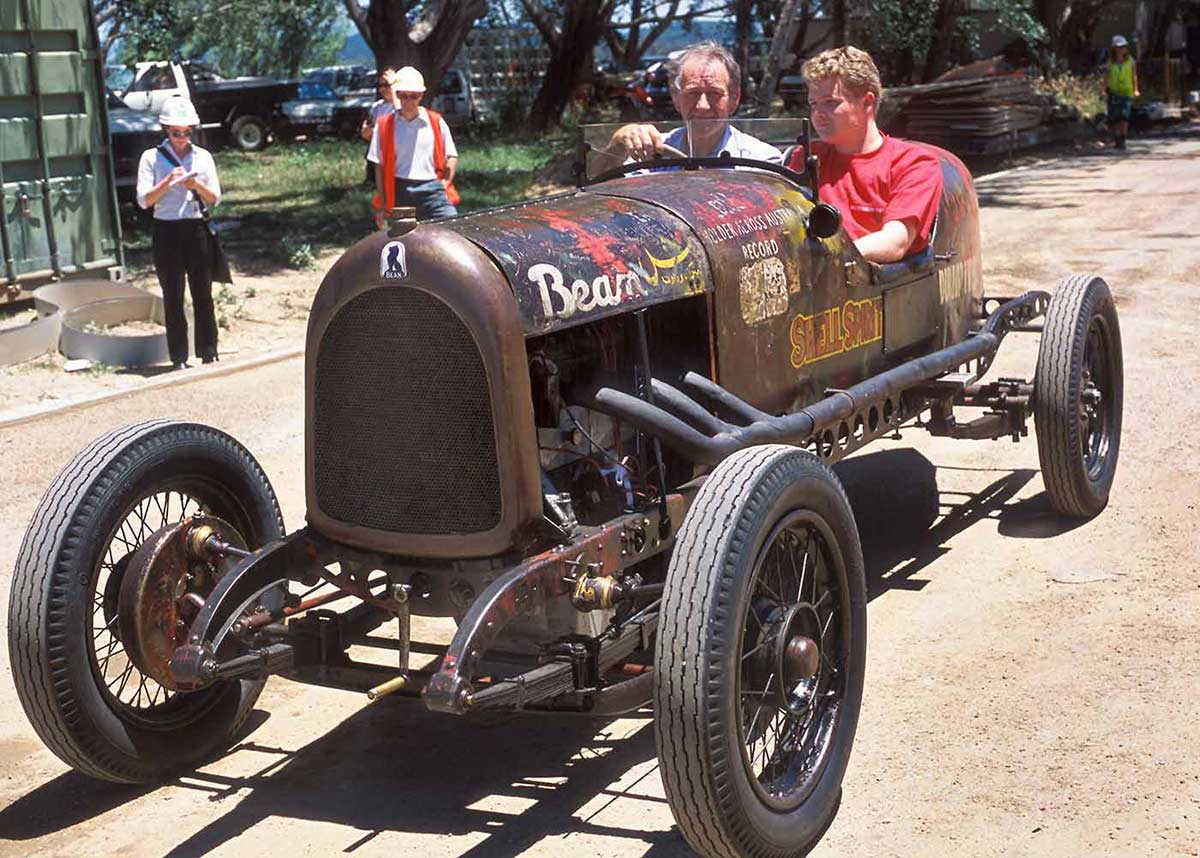
Car acquired by Museum
The Sundowner, in comparison, led a sadly undistinguished existence.
In 1929 it was presented to the Australian Government to preserve in a National Museum in Canberra, despite the fact that no such institution existed at the time.
After many years of languishing in a series of anonymous sheds, it was partially restored during the 1960s by two employees of the Department of Transport, Garth Fisher and Des Rees.
The car officially joined the collection of the National Museum of Australia in 1981. It underwent almost a year of comprehensive conservation work in the late 1990s, with Museum conservators aiming to preserve the vehicle's function and important indicators of its historical significance.
Today the Sundowner's battered, dented and scratched body still bears witness to its extraordinary journey across the world. Although now missing headlights, mudguards and bumper, it still appears much as it did on arriving in Melbourne in 1928, down to the traces of Middle-Eastern sand and South-East Asian mud caked on its underside.
More Sundowner material
The National Museum has several other collections relating to the Sundowner. One of the most interesting is the John Coughlan collection of photographs and correspondence donated by a relative of the mechanic who drove the Bean truck during the 1926 Darwin to Melbourne dash.
The Thomas McGhie collection, donated by a relative of an Australian representative for the Bean company, includes the hood ornament from the Sundowner which later became detached from the car.
One of the most significant archival collections was acquired by motoring journalist Peter Wherrett while researching Grit, his fictionalised account of the 1927–28 London to Melbourne journey. This collection includes unique photographs of the trip, advertisements featuring the Sundowner and rare copies of Birtles' books Battle Fronts of Outback and Lonely Lands: Through the Heart of Australia.
In our collection
References
Francis Birtles, Battle Fronts of Outback, Angus and Robertson, Sydney, 1935.
Francis Birtles, Lonely Lands: Through the Heart of Australia, NSW Bookstall Co, Sydney, 1909.
